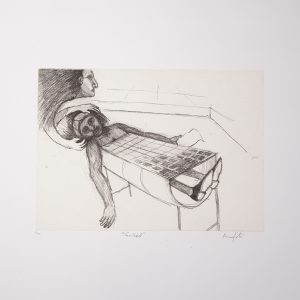Goodman Gallery, Johannesburg
20.08.2016 – 14.09.2016
Goodman Gallery is darkened, with a single work visible upon entry to the gallery. This minimal approach to display conveys a seriousness which is echoed in the images. The first work the viewer is faced with is From Roja Series, a black and white photographic still. It is haunting, desolate, and quiet. The architectural lines create a stark setting for a woman standing in a low-cut black dress, looking slightly up beyond the camera, arms resting by her sides. The world behind the building is an empty grey space. The building, The Egg on the Empire State Plaza is a sculptural concrete form against which the woman seems minituarised. The same plaza features in another work, Soliloquy Series, an image of a woman standing in full black dress, but this time with a covered head, in front of the New York State Museum. Referring to this still in a lecture, Neshat states that she is, ‘A woman standing simultaneously on the threshold of East and West, Modernity and tradition.’ She repeatedly explores her dichotomous existence in her work through the values implicit in architecture, ‘power and problematics’ of each country, visible in its monumental structures.
I find the display of From Roja Series (2016) and Soliloquy Series (1999), on the same show meaningful, and a particularly interesting juxtaposition. In reality, the buildings exist on separate ends of the same plaza, images and experiences from different times in Neshat’s life. In one image, the woman is fully covered, in the other the woman has her hair and flesh exposed. The buildings themselves are in also contrast with one another, the hard lines of symmetry in one, the soft curvilinear form of the other. The display of both these works on the same exhibition engages with her use of contrast and comparison. Interestingly both buildings were opened in the late 1970s, around the same time Neshat moved to the United States, the same period as the 1979 revolution in Iran. Speculatively, this connection seems more than a coincidence in the body of work by an artist so deeply affected and informed by the events from this slice of history. It’s a direct comparison between her two homes – the one she was born to, and the one where she finds herself in exile.
The artist has often created works in which opposing events, films, are happening on walls facing each other. The works speak to, and reflect one another, creating meaning. She has repeatedly played male against female, West versus East, and created ambiguity between dreams and reality. Her first ever film installation Turbulent, an incredibly powerful filmic and musical work in which a man sings the lyrics of the 13th-century Iranian mystical poet Rumi to an all-male audience, while on the other a female musician sings a haunting wordless song to an empty hall.
It doesn’t take much research to realize that there is a microscope aimed at Neshat’s work. A 2015 retrospective at the Hirshhorn, Shirin Neshat: Facing History in Washington D.C.; a TED Talk in 2010; a lecture at the University of California, Berkeley in 2013; and a number of prestigious art and film awards to her name; Shirin Neshat’s output has global attention. According to Shiva Balaghi, professor of Iranian studies at Brown University, she is the ‘first-ever Middle Eastern artist and first woman artist since 2009 to receive recognition in a monographic show at the Hirshhorn.’
Neshat is a masterful artist and director, creating allegorical and highly complex conceptual works. With this kind of expertise comes the immense pressure of her audience looking to her for ways to question paradigms of power in the East and to create meaning and place for this within the West. Yet, she states resolutely that she is not a cultural interpreter, but that her works reflect her own experience, that her films are works of fiction, and memory. Neshat’s female characters in her film installations are often autobiographical, absolutely the case in both Sarah, 2016 and Roja, 2016 which form part of a trilogy called Dreamers. The deeply personal, phantasmagorical film installations in the Dreamers trilogy are an exploration of this pressure, dreams and nightmares experienced by the artist. She has an intense focus on the power and presence of women. Neshat interrogates everything from her own perspective, from what she considers a sense of nostalgia – she isn’t recounting history, but constructing a narrative in which women play a central fictional role based on the experience of the artist.
Neshat’s work speaks to the contemporary moment in myriad ways, complex, entwined narratives run through her work that creep beyond the borders of her subject matter and own experience into deeply existential themes and questioning. With themes of displacement, explorations of existing power structures and ideologies, this exhibition felt incredibly relevant.









